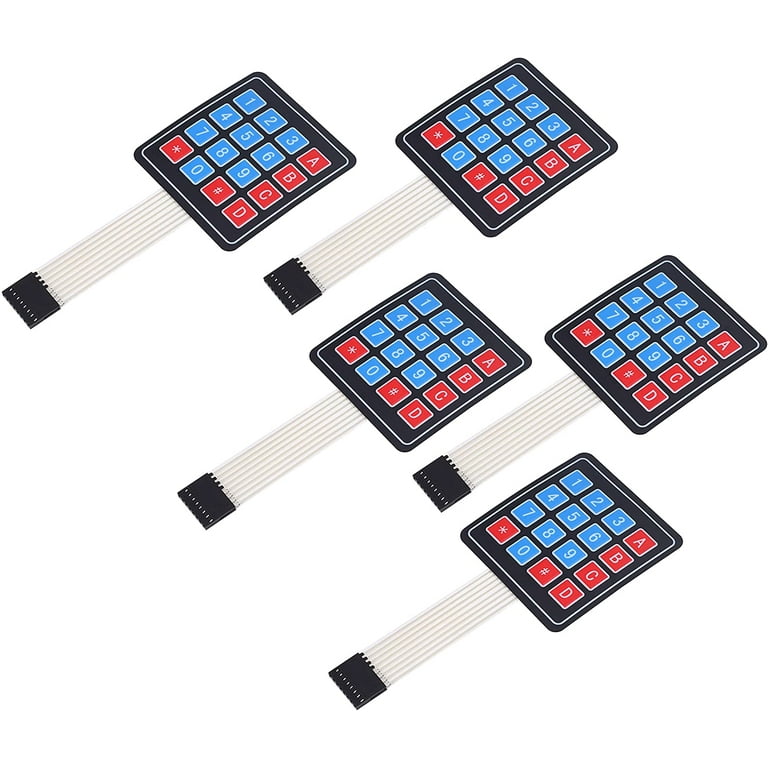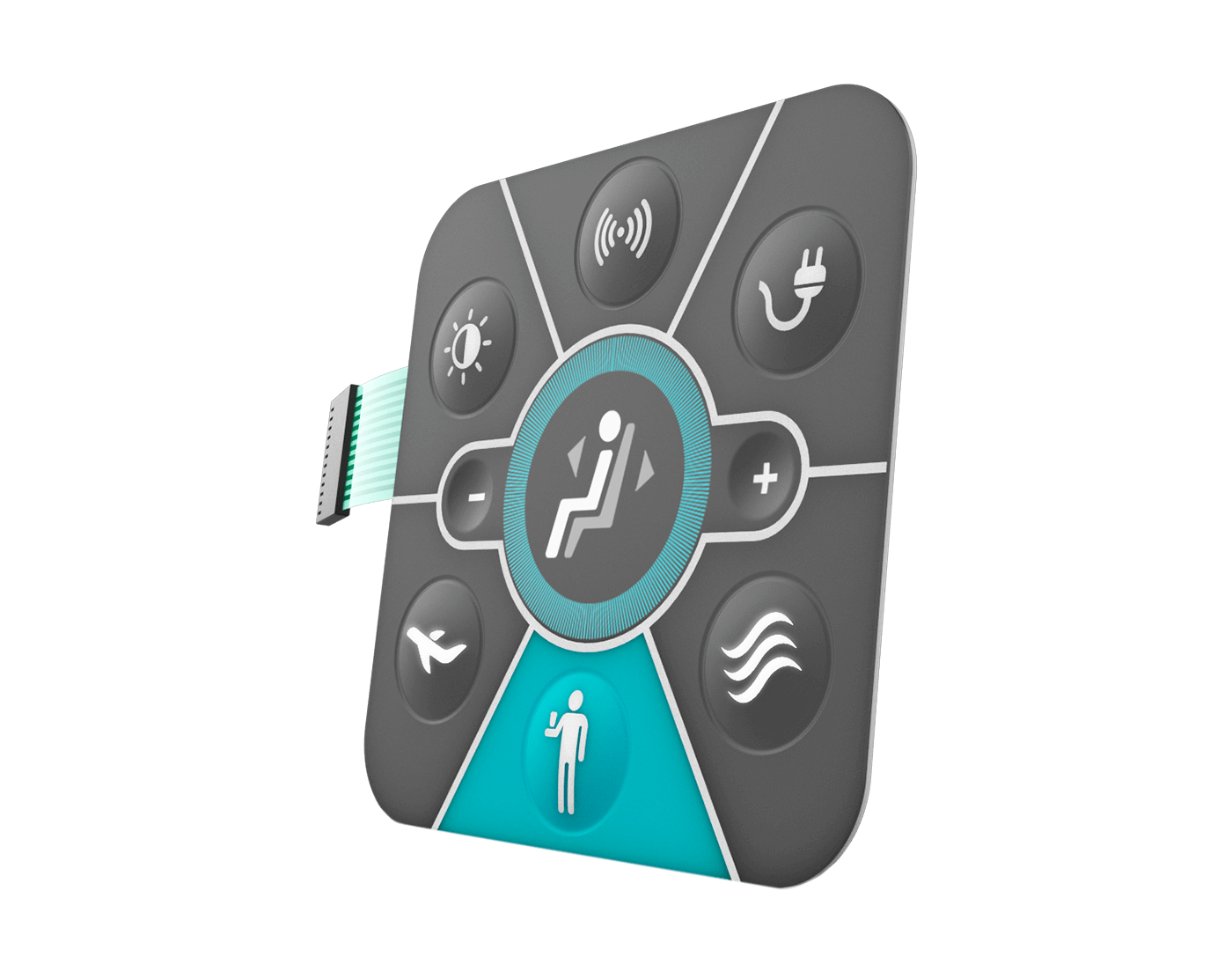Your Dependable Membrane Switch Manufacturer for Industrial Applications
Your Dependable Membrane Switch Manufacturer for Industrial Applications
Blog Article
Checking Out the Manufacturing Process of Membrane Switch for Different Industries
The manufacturing process of Membrane buttons is a complicated venture that demands precision and focus to detail. From selecting appropriate products to applying strenuous quality assurance procedures, each action plays a crucial role in ensuring performance. Numerous sectors, including automotive and clinical, depend on these components for their special applications. Recognizing the intricacies of this procedure discloses substantial insights right into just how these buttons are produced and their effect throughout diverse fields.
Recognizing Membrane Changes: A Summary

Trick Materials Used in Membrane Switch Manufacturing
In Membrane switch manufacturing, the choice of vital materials significantly affects functionality and sturdiness. Conductive products, adhesives, and layers play crucial functions, while substrate choice affects general efficiency and integrity. Recognizing these parts is necessary for enhancing the design and production of Membrane buttons.
Conductive Materials Introduction
Conductive materials play a crucial duty in the functionality of Membrane switches, making sure reliable electrical connections within the tool. Commonly used materials include silver, copper, and carbon-based inks, each offering distinctive advantages. Silver is favored for its high conductivity and sturdiness, making it excellent for applications requiring robust efficiency. Copper, while a little much less conductive than silver, is a cost-efficient alternative commonly made use of in printed circuits. Carbon-based inks give a versatile choice, appropriate for applications where adaptability and reduced prices are focused on, although they have lower conductivity compared to metal options. The choice of conductive products straight impacts the overall reliability, lifespan, and performance of the Membrane button, making it an essential factor to consider in the production process.
Adhesives and Coatings
Adhesives and coatings are crucial parts in the manufacturing of Membrane switches, providing important bonding and safety buildings. These materials ensure that numerous layers of the button, consisting of visuals overlays and wiring, adhere securely to each other, enhancing toughness and performance. Frequently used adhesives include pressure-sensitive adhesives (PSAs) and epoxy-based formulas, which provide solid adhesion and resilience. Coatings, such as polyurethane or acrylic, offer to shield versus environmental factors, consisting of moisture, abrasion, and chemicals. Additionally, coatings can enhance tactile comments and visual allure, contributing to the overall individual experience. The choice of proper adhesives and finishes is important for optimizing performance and longevity in diverse applications across numerous sectors, making sure that Membrane switches meet details functional demands.
Substratum Choice Elements
Substratum option plays an essential duty in the manufacturing of Membrane switches, as it substantially affects their overall efficiency and sturdiness. Secret materials such as polyester, polycarbonate, and adaptable printed motherboard (FPCBs) are generally made use of for their distinct properties. Polyester is preferred for its cost-effectiveness and resistance to abrasion, making it appropriate for applications with high wear. Polycarbonate deals exceptional quality and impact resistance, suitable for settings needing high presence. FPCBs provide improved flexibility and are frequently utilized in intricate designs. The option of substratum additionally impacts variables like thermal stability, chemical resistance, and convenience of printing. Eventually, choosing the ideal substrate is critical for making certain the functionality and durability of Membrane changes across various markets.
The Style Refine of Membrane Switches Over
The design process of Membrane buttons is an essential phase that considerably affects the capability and aesthetic appeals of the last product - membrane switch manufacturer. It starts with defining the specific demands of the application, consisting of measurements, switch layout, and responsive responses choices. Developers have to take into consideration customer communication, making certain that the button is user-friendly and accessible.Next, products are chosen based upon sturdiness, flexibility, and environmental resistance. The integration of graphics and branding aspects is likewise vital, as it more tips here boosts visual appeal and communication. Prototyping allows for iterative testing, enabling changes based on customer responses and efficiency evaluations.Additionally, the layout has to represent the electric elements, such as connectors and circuits, guaranteeing integrity and ease of use. Inevitably, a successful layout integrates performance, aesthetics, and customer experience, leading the method for effective manufacturing and lasting efficiency in different sectors
Printing Strategies for Membrane Switches Over
The printing methods made use of in Membrane switch production play an important function in identifying the end product's top quality and capability. Screen printing offers benefits such as resilience and lively color application, while electronic printing developments provide versatility and precision in layout. Understanding these approaches can significantly influence the general performance of Membrane switches in numerous applications.
Screen Printing Benefits
Countless advantages make display publishing check these guys out a preferred method for producing Membrane buttons. This method enables high-quality, comprehensive layouts and lively shades, which are vital for interface applications. Display printing is especially effective for applying thick ink layers, improving longevity and tactile responses. On top of that, it supplies outstanding bond to numerous substrates, ensuring durability sought after settings. The procedure is cost-effective for huge manufacturing runs, as it decreases configuration time and waste. In addition, display printing sustains a variety of inks, consisting of specialty and UV-curable choices, making it possible for flexibility in design. Its ability to produce regular results throughout multiple devices makes it a reputable selection for suppliers intending for high quality and effectiveness in Membrane switch manufacturing.
Digital Printing Innovations

Developments in digital printing technology are changing the production of Membrane switches, supplying manufacturers ingenious remedies that enhance style versatility and efficiency. Digital printing permits high-resolution graphics and elaborate layouts, enabling personalized branding and performance without the constraints of conventional methods. This technique minimizes setup times and costs, facilitating much shorter manufacturing runs and minimal waste, making it ideal for services with differing demands. Furthermore, advancements in ink formulations give better resilience and attachment, making certain long life in different settings. As sectors increasingly seek complicated and tailored designs, digital printing sticks out as a vital method, establishing a brand-new standard in Membrane button manufacturing. The integration of these developments positions producers to satisfy progressing market needs properly.
Setting up and Layering of Membrane Switch Parts
Mindful setting up and layering of Membrane button parts are important to assuring capability and sturdiness. This process starts with the precise positioning of different layers, including the graphic overlay, adhesive, circuit layer, and support product. Each part has to be carefully positioned to maintain electrical honesty and customer interface responsiveness.During setting up, conductive traces are related to the circuit layer, typically made from products like polyester or polycarbonate. This layer is critical, as it beams when pressure is used. The adhesive made use of for bonding these layers is also selected for its capacity to withstand ecological anxieties while preserving a safe bond.Heat and stress are commonly applied throughout the assembly procedure to ascertain that the layers stick correctly without endangering the functionality of the button. Interest is provided to the side sealing to protect versus moisture and impurities, protecting the durability of the Membrane button in various commercial applications.
Quality Assurance Measures in Membrane Switch Manufacturing
Quality control procedures play an important duty in making sure the reliability and efficiency of Membrane switches following the setting up and layering of their parts. In the production procedure, several vital evaluations are conducted to maintain quality requirements. These consist of aesthetic inspections for issues in printing and adhesive application, in addition to useful tests to confirm the responsiveness of each switch.Additionally, environmental testing is done to assess the buttons' sturdiness versus temperature level changes and moisture exposure. Producers often carry out analytical process control (copyright) methods to monitor production consistency, making it possible for early discovery of anomalies.Furthermore, traceability systems are developed to track components and materials, making certain accountability and helping with recalls if required. Calibration of tools and adherence to industry criteria are additionally essential to maintaining product stability. Collectively, these quality assurance procedures safeguard the efficiency of Membrane switches over across various applications, ultimately enhancing customer fulfillment.
Applications of Membrane Switches Across Different Industries
Membrane buttons are utilized across a diverse array of industries, showcasing their adaptability and versatility. In the medical market, they supply dependable and waterproof user interfaces for devices such as diagnostic devices and mixture pumps, making sure hygiene and convenience of usage. The vehicle market employs Membrane buttons for control panel controls, allowing seamless interaction between the motorist and lorry systems.In consumer electronic devices, these buttons are found in appliances and portable gadgets, providing a smooth, modern visual while enhancing capability. Industrial applications likewise take advantage of Membrane changes for equipment control board, where resilience and resistance to harsh problems are essential.Furthermore, the aerospace and defense sectors use Membrane buttons for cockpit instrumentation and interaction systems, focusing on reliability and efficiency under extreme problems. Generally, read this article Membrane buttons play an important function in boosting the individual experience and operational performance across numerous domains.
Often Asked Concerns
The length of time Does It Require To Manufacture a Membrane Layer Switch?
The production time for a membrane switch typically varies from a few days to several weeks - membrane switch manufacturer. Elements affecting this duration include layout complexity, product accessibility, and production quantity, all influencing the overall timeline considerably
What Is the Regular Life-span of a Membrane Layer Switch?
The common life-span of a membrane button generally ranges from 1 to 5 million actuations, relying on factors such as material top quality, environmental conditions, and usage frequency, substantially affecting durability and overall performance.
Can Membrane Switches Over Be Custom-made for Specific Applications?
Membrane switches can certainly be customized for certain applications. Their layout adaptability enables alterations in size, shape, colors, and graphics, making sure compatibility with special needs across different markets and improving performance and individual experience.

Are Membrane Switches Over Eco-friendly?
The environmental influence of Membrane switches over differs. Some products made use of may not be green, while improvements in making processes are significantly concentrating on sustainability, aiming to lower waste and advertise recyclable elements in their manufacturing.
What Are the Common Failure Settings of Membrane Buttons?
Typical failure modes of Membrane buttons consist of delamination, adhesive failing, damage from usage, wetness access, and electric failures. These problems can considerably influence capability, performance, and lifespan in different applications across various industries. Membrane switches can be tailored to fit details style needs, such as shape, size, and performance, making them very adaptable.The building and construction commonly involves multiple layers, consisting of a graphic overlay, sticky, and a circuit layer, which function together to create a smooth individual experience. In Membrane button manufacturing, the option of vital materials significantly influences performance and toughness. The automotive sector uses Membrane buttons for dashboard controls, enabling seamless interaction between the motorist and automobile systems.In consumer electronic devices, these switches are located in devices and handheld tools, using a sleek, modern aesthetic while enhancing performance. Industrial applications additionally take advantage of Membrane changes for machinery control panels, where resilience and resistance to extreme conditions are essential.Furthermore, the aerospace and defense markets use Membrane buttons for cockpit instrumentation and communication systems, focusing on reliability and performance under severe conditions. Membrane buttons can certainly be personalized for particular applications.
Report this page